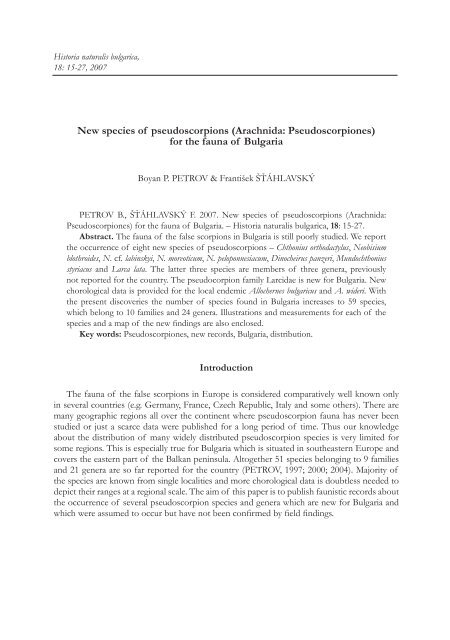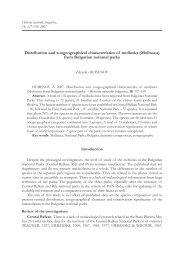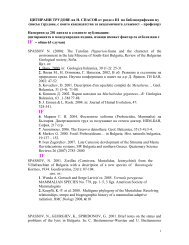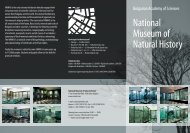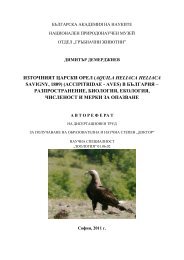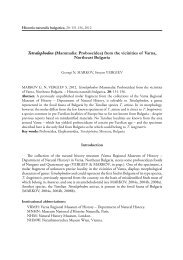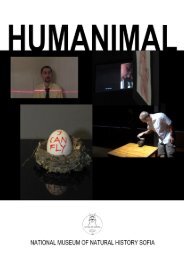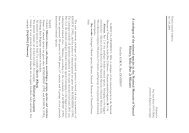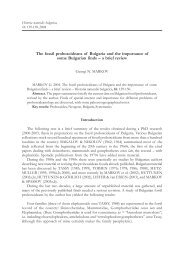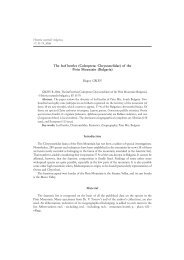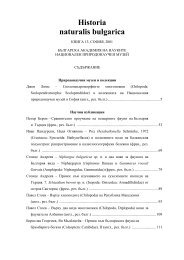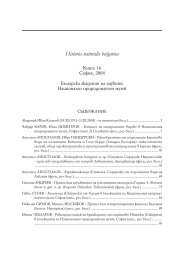New species of pseudoscorpions (Arachnida: Pseudoscorpiones ...
New species of pseudoscorpions (Arachnida: Pseudoscorpiones ...
New species of pseudoscorpions (Arachnida: Pseudoscorpiones ...
- No tags were found...
Create successful ePaper yourself
Turn your PDF publications into a flip-book with our unique Google optimized e-Paper software.
16 Boyan Petrov & František ŠťáhlavskýMaterial and methodsPseudoscorpions were hand-collected under stones, tree barks or logs. Litter dwelling<strong>species</strong> were sifted with a common entomological hand sieve (hole diameter = 8 mm). Thematerial is preserved in 70% ethanol and deposited in the arachnological collection <strong>of</strong> theNational Museum <strong>of</strong> Natural History in S<strong>of</strong>ia (NMNHS) or in the collection <strong>of</strong> F. Šťáhlavský.The number from the museum’s collection database is indicated in square brackets. Largerspecimens were examined under stereo microscope. Members <strong>of</strong> the family Chthoniidae weredissected and examined under a microscope. Larger specimens were measured in a slightlyconcaved microscope slide without dissection. Smaller parts were measured under microscope.Only the movable palpal finger was measured and further considered. All measurementsare given in millimeters. Systematic arrangements follows HARVEY (1990, 1992). The newlocalities are shown on Fig. 18.Taxonomic partFamily ChthoniidaeChthonius (Chthonius) orthodactylus (Leach, 1817)Material examined: SW Bulgaria, Pirin Mt., Sugarevo, Distr. Sandanski, alt. 750 m, understone, 3.10.1999, F. Šťáhlavský leg., 1 ♂; SW Bulgaria, Pirin Mt., between Sugarevo and Pirinhut, alt. 900 m, under stones, F. Šťáhlavský leg., 4.10.1999, 1 ♂, 5 ♀♀ (Fig. 1).Measurements <strong>of</strong> 2 ♂♂ and 5 ♀♀: Body length 1.19-1.40 (♂), 1.44-1.56 (♀); Cephalothoraxlength 0.38 (♂), 0.39-0.46 (♀); Pedipalps: Femur length 0.50-0.51 (♂), 0.47-0.56 (♀); breadth0.09 (♂), 0.10-0.11 (♀); ratio 5.54-5.62 (♂); 4.10-5.24 (♀); Tibia length 0.20 (♂), 0.20-0.23 (♀);breadth 0.10 (♂), 0.10-0.12; ratio 2.00 (♂), 1.98-2.01 (♀); Chelal palm length 0.25-0.26 (♂), 0.27-0.29 (♀); breadth 0.13 (♂), 0.15-0.17 (♀); Chelal finger length 0.46-0.48 (♂), 0.47-0.53 (♀).Remarks: Although this <strong>species</strong> is known from the neighbouring countries it has not beenreported yet for Bulgaria. It lives mainly in the soil and in the leaf litter but can also be foundunder stones.Mundochthonius styriacus Beier, 1971Material examined: SW Bulgaria, Pirin Mt., Lilyanovo, Distr. Sandanski, alt. 600 m, treehollow <strong>of</strong> Platanus orientalis, F. Šťáhlavský leg., 7.10.1999, 3 ♀♀ (Figs 2-4).Measurements <strong>of</strong> 2 ♀♀: Body length 1.05; Cephalothorax length 0.44; Pedipalps: Femurlength 0.38-0.39; breadth 0.10-0.11; ratio 3.52-3.78; Tibia length 0.20-0.21; breadth 0.11-0.12;ratio 1.72-1.85; Chelal palm length 0.23-0.23; breadth 0.13; Chelal finger length 0.38-0.39.Remarks: <strong>New</strong> genus and <strong>species</strong> for Bulgaria. Only few specimens <strong>of</strong> this <strong>species</strong> are knownfrom several localities in Austria (BEIER, 1971), Switzerland (MAHNERT, 1979) and Germany(JOST, 1982). In the Czech Republic it was proved to be more common (ŠŤÁHLAVSKÝ &DUCHÁČ, 2001). This small <strong>species</strong> (body length around 1 mm) inhabits hollow trees mainlywith humid substrate (ŠŤÁHLAVSKÝ, 2001).
<strong>New</strong> <strong>species</strong> <strong>of</strong> <strong>pseudoscorpions</strong>... 17Figs. 1-4. 1 – left palpal hand <strong>of</strong> a female Chthonius orthodactylus, scale line 0.3 mm; 2-4 Mundochthoniusstyriacus, female: 2 – carapace, 3 – right pedipalp, scale lines 0.5 mm; 4 – left palpal hand, scale line 0.25 mm
18 Boyan Petrov & František ŠťáhlavskýFamily LarcidaeLarca lata (Hansen, 1884)Material examined: SE Bulgaria, Black Sea coast, 3 km west <strong>of</strong> Tsarevo, Distr. Burgas, treehollow <strong>of</strong> Quercus sp., J. Hájek leg., 26.6.1999, 2 ♂♂ (Figs 5-6), 2 ♀♀.Measurements <strong>of</strong> 2 ♂♂ and 2 ♀♀: Body length 1.92-1.97 (♂), 2.12-2.14 (♀); Cephalothoraxlength 0.45-0.53 (♂), 0.49-0.51 (♀); Pedipalps: Femur length 0.70-0.71 (♂), 0.73 (♀); breadth0.16 (♂), 0.17 (♀); ratio 4.49-4.58 (♂), 4.33-4.35 (♀); Tibia length 0.56-0.61 (♂), 0.58-0.60 (♀);breadth 0.17-0.18 (♂), 0.18-0.19; ratio 3.24-3.49 (♂), 3.11-3.19 (♀); Chelal palm length 0.52-0.54 (♂), 0.53-0.54 (♀); breadth 0.21 (♂), 0.22-0.24 (♀); Chelal finger length 0.36-0.40 (♂), 0.42(♀).Remarks: <strong>New</strong> family, genus and <strong>species</strong> for Bulgaria. The range <strong>of</strong> the <strong>species</strong> includesAustria, Czech Republic, Denmark, England, Poland, Romania, Sweden, Latvia and theNetherlands (ZARAGOZA, 2005). L. lata is a common dweller <strong>of</strong> tree hollows with dry andfine-grained substrate. Rarely inhabits synantropic localities (l<strong>of</strong>t, barn) and occasionally occursin caves. For Romania it was recorded from the cave “Canaraua fetei” close to the border withBulgaria (DUMITRESCO & ORGHIDAN, 1964). The new locality is the southernmost onewithin the range <strong>of</strong> the <strong>species</strong> extending its border with ca. 300 km southwards.Family NeobisiidaeNeobisium blothroides (Tömösváry, 1882)Material examined: NW Bulgaria, Vartop, Distr. Vidin, cave Prileparnika, P. Stoev, T.Ivanova leg., 23.2.1995, 1 ♀ (Figs. 7-8) [NMNHS BP № 87]; Romania, National Park ValeaCernei, 4 km before Cerna Sat, Distr. Baile Herculane, alt. 620 m, beech litter over a karsticscree, B. Petrov, P. Stoev leg., 12.5.2000, 1 ♀ [NMNHS № 854].Measurements <strong>of</strong> 2 ♀♀: Cephalothorax length 1.11-1.25, breadth 1.04-1.19; Pedipalps:Femur length 1.79-2.03; breadth 0.35-0.38; ratio 5.18-5.28; Tibia length 1.16-1.44; breadth 0.38-0.42; ratio 3.03-3.41; Chelal palm length 1.40-1.44; breadth 0.69-0.79; Chelal finger length 2.00-2.12.Remarks: This large neobisiid <strong>species</strong> belongs to blothroides – praecipuum <strong>species</strong> group <strong>of</strong>Neobisium s.str. (BEIER, 1947). Compared to N. biharicum Beier [palpal femur x 4.6 – 4.93 longerthan broad; tibia x 2.9 – 3.1 after BEIER (1963) and ĆURČIĆ et al. (1993)] both examinedblothroides specimens have slender palpal femur (x 5.18 – 5.28) and tibia (x 3.41 – 3.55) (seebelow). However these ratios have lower values compared to those (femur x 5.5 – 5.6; tibia x3.8 – 4) pointed by BEIER (1947) and by ĆURČIĆ et al. (2005) – femur x 5.34 and tibia x 3.56in 1♀). Morphologically, the examined specimens fit well in the <strong>species</strong>’ diagnosis as describedby ĆURČIĆ et al. (2005). In comparison, N. praecipuum has thicker palpal femur (x 4.6) andtibia (x 3.1) (HEURTAULT, 1968). Compared to N. biharicum (as in ĆURČIĆ et al., 1993), ISTtrichobothrium is situated between ST and T in the studied two N. blothroides specimens (Fig. 8).IST is 2.7 times closer to the tip <strong>of</strong> the finger than to IB. The epistomal process <strong>of</strong> the carapaceis relatively small but clearly pointed. The posterior eyes are flattened, spot-like. There are 6setae in the posterior row. The chelicera bears 8 setae. The teeth <strong>of</strong> the fixed palpal finger staydense but distinct almost to the base. To the middle, between B and SB trichobothria level, allteeth are pointed. The teeth <strong>of</strong> the movable finger stay relatively distinct and all are flattenedfrom the finger tip to the base. The locality in Bulgaria is in fact the southernmost within the
20 Boyan Petrov & František ŠťáhlavskýFigs. 5-8. 5-6 Larca lata, male: 5 – right palpal hand, 6 – leg IV, scale lines 0.5 mm; 7-8 Neobisiumblothroides, female (NMNHS BP № 87): 7 – left palp, 8 – palpal fingers, scale lines 1 mm
<strong>New</strong> <strong>species</strong> <strong>of</strong> <strong>pseudoscorpions</strong>... 21Figs. 9-13. 9-11 Neobisium cf. labynskyi, female (NMNHS № 842): 9 – right palpal hand, scale line 1mm, 0.25 mm for the teeth; 10 – left palp, 11 – carapace, scale lines 1 mm (NMNHS № 930); 12-13 Neobisium moreoticum, female: 12 – carapace, (NMNHS № 1004); 13 – left palp, scale line 1 mm(NMNHS № 1101)
22 Boyan Petrov & František ŠťáhlavskýDistr. Malko Tarnovo, Tisovitsa Reserve, alt. 300 m, Fagus orientalis – Rhododendron ponticum litter,12.07.2002, B. Petrov leg., 1 ♂, 2 ♀♀, 5 nymphs [NMNHS № 1030]; SE Bulgaria, StrandjaMt., Primorsko, Distr. Burgas, cape Maslen Nos, alt. 80 m, litter <strong>of</strong> Quercus cerris, 19.4.2002, B.Petrov leg., 1 ♂, 1 ♀ [NMNHS № 1032]; SE Bulgaria, Strandja Mt., Primorsko, Distr. Burgas,Ropotamo Reserve, close to the mouth <strong>of</strong> Ropotamo River, alt. 20 m, litter <strong>of</strong> Quercus spp.,21.4.2001, B. Petrov leg., 3 ♀♀ (Fig. 13) [NMNHS № 1101]; idem., Arkutino swamp, 29.4.2003,B. Petrov, 1♂ [NMNHS № 1065].Measurements <strong>of</strong> 2 ♂♂ and 8 ♀♀: Cephalothorax length 0.88-0.92 (♂), 0.83-0.88 (♀);Pedipalps: Femur length 1.15-1.17 (♂), 1.09-1.23 (♀), 0.98 (TYPE); breadth 0.26 (♂), 0.23-0.27 (♀), 0.22 (TYPE); ratio 4.45-4.52 (♂), 4.38-5.01 (♀), 4.45 (TYPE); Tibia length 0.83-0.84(♂), 0.83-0.86 (♀), 0.65 (TYPE); breadth 0.31 (♂), 0.29-0.31 (♀), 0.31 (TYPE); ratio 2.69-2.72(♂), 2.69-2.87 (♀), 2.5 (TYPE); Chelal palm length 0.86-0.88 (♂), 0.83-0.96 (♀), 0.78 (TYPE);breadth 0.48-0.54 (♂), 0.46-0.54 (♀), 0.45 (TYPE); Chelal finger length 1.17-1.27 (♂), 1.19-1.27(♀), 0.9 (TYPE).Remarks: Limited and to certain extent inconsistent descriptions <strong>of</strong> this <strong>species</strong> are publishedin the literature. It was originally described from Southern Greece (Peloponnesus) by BEIER(1931). RAFALSKI (1949) has identified several specimens as N. moreoticum from Caucasus. Thepalpal measurements and ratios <strong>of</strong> his samples differ from those <strong>of</strong> the type series. This recordhas no pictures to compare the morphological identity. Another record from Greece (SantoriniIsland) was published by SCHMALFUSS & SCHAWALLER (1984). The morphology <strong>of</strong> thespecimens from Strandja Mt. (Bulgaria) well fits the original Beier‘s description. The measurementsand the ratios <strong>of</strong> the palps in 2 ♂♂ and 8 ♀♀ are slightly higher than those published by BEIER(1963). The IST trichobothrium <strong>of</strong> the fixed finger is exactly at the ST level on the movable one(in SCHMALFUSS & SCHAWALLER (1984) IST is proximally located) (Fig. 13).Neobisium peloponnesiacum (Beier, 1928)Material examined: NW Bulgaria, Vrachanska planina Mt., NP Vrachanski Balkan,Climbers’ Home /Dom na alpinista above Vratsa town, alt. 420 m, under stones, 12.4.1998, S.Lazarov leg., 1♀ [NMNHS-BP № 301]; idem., 30.10.2000, B. Petrov leg., 1♂, 2♀♀ (Figs 14-15)[NMNHS № 924].Measurements <strong>of</strong> 1 ♂ and 3 ♀♀: Cephalothorax length 0.998 (♂), 0.864-0.998 (♀);breadth 0.979 (♂); 0.96-1.094 (♀); Pedipalps: Femur length 1.286 (♂), 1.248 (♀), 1.15 (Beier’sTYPE); breadth 0.326 (♂), 0.326-0.346 (♀), 0.35 (TYPE); ratio 3.94 (♂), 3.61-3.83 (♀), 3.29(TYPE); Tibia length 1.037 (♂), 1.018-1.037 (♀), 0.87 (TYPE); breadth 0.48 (♂), 0.461-0.488(♀), 0.48 (TYPE); ratio 2.16 (♂), 2.09-2.21 (♀), 1.8 (TYPE); X 0.346 (♂), 0.355-0.384 (♀); Y0.691 (♂), 0.614-0.653 (♀); ratio X/Y 0.50 (♂), 0.56-0.59 (♀); Chelal palm breadth 0.672 (♂),0.634-0.768 (♀), 0.72 (TYPE); length 0.998 (♂), 1.133-1.19 (♀), 1.1 (TYPE); Chelal fingerlength 1.075 (♂), 1.056-1.133 (♀), 1 (TYPE).Remarks: Together with N. cephalonicum and N. reitteri, N. peloponnesiacum is the largest neobisiidwith prominent tibia <strong>of</strong> a Roncus type. The original description was based upon relatively largetype series (26 adults and 4 nymphs) but considering the available morphometric data only fewspecimens were measured and further considered (BEIER, 1928; 1932; 1963). Our individualsare slightly larger in size and some palpal ratios differ from the published values. However themorphology <strong>of</strong> the examined specimens well fits the original Beier’s description. The carapaceis broader than long, the epistome is small and pointed. The eyes are big and all four haveprominent lenses. There are 14-15 setae <strong>of</strong> the posterior row. The palps are big and stout (Fig.
<strong>New</strong> <strong>species</strong> <strong>of</strong> <strong>pseudoscorpions</strong>... 2315). The tibia is clearly rounded and the X-Y ratio is 0.50-0.59 (cf. GABBUTT & VACHON,1965). The IST trichobothrium stays slightly proximal from the middle <strong>of</strong> the finger, betweenSB and ST trichobothria (Fig. 14). The teeth <strong>of</strong> the fixed palpal finger are pointed, retroconicalalmost to the base. The teeth <strong>of</strong> the movable finger stay dense and rounded throughout. Theteeth on the fixed finger <strong>of</strong> the chelicerae are almost equal in size, the galea is fully flattened.Since its first discovery, the <strong>species</strong> has never been reported out <strong>of</strong> Peloponnesus in Greece.The new localities broaden the range <strong>of</strong> the <strong>species</strong> with ca. 650 km northwards.Family ChernetidaeAllochernes bulgaricus Hadži, 1940Material examined: SW Bulgaria, Pirin Mt., Sugarevo, Distr. Sandanski, tree hollow <strong>of</strong>Carpinus sp., 3.10.1999, F. Šťáhlavský leg., 2 ♂♂, 2 ♀♀, 4 tritonymphs; SW Bulgaria, PirinMt., between Lilyanovo and Yane Sandanski hut, rotten trunk <strong>of</strong> Fagus sylvatica, 8.10.1999, F.Šťáhlavský leg., 1 ♂, 1 ♀; SW Bulgaria, Rila Mt., Panichishte resort area, alt. 1400 m, in nest <strong>of</strong>Formica rufa, 29.7.1998, A. Lapeva leg., 37 specimens [NMNHS № 813, 813a].Measurements <strong>of</strong> 3 ♂♂, 3 ♀♀ and 4 tritonymphs from Pirin Mt.: Body length 1.56-1.63 (♂), 1.80-1.95 (♀), 1.13-1.54 (T); Cephalothorax length 0.56-0.57 (♂), 0.58-0.61 (♀), 0.47-0.52 (T); Pedipalps: Femur length 0.47-0.52 (♂), 0.51-0.55 (♀), 0.35-0.39 (T); breadth 0.17-0.19(♂), 0.16-0.18 (♀), 0.12-0.14 (T); ratio 2.42-2.98 (♂), 2.89-3.52 (♀), 2.71-3.13 (T); Tibia length0.40-0.45 (♂), 0.45-0.49 (♀), 0.31-0.34 (T); breadth 0.17-0.19 (♂), 0.19-0.21 (♀), 0.14-0.16 (T);ratio 2.21-2.62 (♂), 2.33-2.48 (♀), 1.99-2.19 (T); Chelal palm length 0.42-0.43 (♂), 0.45 (♀),0.33-0.35 (T); breadth 0.22-0.23 (♂), 0.24-0.26 (♀), 0.26-0.29 (T); Chelal finger length 0.32-0.36(♂), 0.36-0.39 (♀), 0.26-0.29 (T).Remarks: Originally the <strong>species</strong> was described as new to the science from Vitosha Mt.above S<strong>of</strong>ia (HADŽI, 1940). With regard to the size, A. bulgaricus is amongst the smallest <strong>species</strong><strong>of</strong> the genus. Besides living under tree barks it was found to occur in ant-nests as many othercongeners. The new localities are located in two mountains (Pirin and Rila), which broaden ourknowledge on the distribution <strong>of</strong> this endemic <strong>species</strong>.Allochernes wideri (C. L. Koch, 1843)Material examined: SW Bulgaria, Pirin Mt., between Pirin and Melnik, tree hollow <strong>of</strong>Platanus sp., 2.10.1999, F. Šťáhlavský leg., 1 ♂; SW Bulgaria, Pirin Mt., Sugarevo, Distr. Sandanski,tree hollow <strong>of</strong> Carpinus sp., 3.10.1999, F. Šťáhlavský leg., 1 ♂, 1 ♀, 2 tritonymphs; SW Bulgaria,Pirin Mt., Lilyanovo, Distr. Sandanski, tree hollow <strong>of</strong> Platanus sp., 7.10.1999, F. Šťáhlavský leg.,1 ♀; idem., 8.10.1999, 1 ♀ (Fig. 16), 3 tritonymphs; SE Bulgaria, Black Sea coast, 3 km west <strong>of</strong>Tsarevo, Distr. Burgas, tree hollow <strong>of</strong> Quercus sp., 26.6.1999, J. Hájek leg., 1 ♀.Measurements <strong>of</strong> 2 ♂♂, 4 ♀♀ and 5 tritonymphs: Body length 2.02-2.30 (♂), 2.09-2.59 (♀), 1.31-1.67 (T); Cephalothorax length 0.66 (♂), 0.71-0.75 (♀), 0.53-0.60 (T); Pedipalps:Femur length 0.58-0.65 (♂), 0.73-0.75 (♀), 0.45-0.51 (T); breadth 0.23-0.25 (♂), 0.25-0.26 (♀),0.16-0.19 (T); ratio 2.51-2.60 (♂), 2.87-3.02 (♀), 2.59-2.62 (T); Tibia length 0.56 (♂), 0.65-0.68 (♀), 0.38-0.43 (T); breadth 0.22-0.24 (♂), 0.25-0.26 (♀), 0.17-0.20 (T); ratio 2.30-2.50 (♂),2.56-2.62 (♀), 2.14 (T); Chelal palm length 0.50-0.51 (♂), 0.55-0.60 (♀), 0.41-0.43 (T); breadth0.30-0.31 (♂), 0.34-0.35 (♀), 0.20-0.25 (T); Chelal finger length 0.44-0.47 (♂), 0.52-0.56 (♀),0.30-0.36 (T).
24 Boyan Petrov & František ŠťáhlavskýFigs. 14-17. 14-15 Neobisium peloponnesiacum: 14 – left palpal hand <strong>of</strong> a female, scale line 0.5 mm(NMNHS № 924); 15 – left palp <strong>of</strong> a male, (NMNHS № 924); 16 – leg IV <strong>of</strong> a female Allocherneswideri; 17 – leg IV <strong>of</strong> a female Dinocheirus panzeri, scale line 0.5 mm
<strong>New</strong> <strong>species</strong> <strong>of</strong> <strong>pseudoscorpions</strong>... 25Remarks: The <strong>species</strong> occurs in many European countries (HARVEY, 1991). It is acommon dweller <strong>of</strong> tree hollows (ŠŤÁHLAVSKÝ, 2001). A. wideri was firstly discovered inBulgaria in the Eastern Rhodopes Mt. (PETROV, 2004) but the present localities indicate widerdistribution in the country.Dinocheirus panzeri (C. L. Koch, 1837)Material examined: SW Bulgaria, Rupite, volcanic hill Kozhuh, Distr. Petrich, alt. 150 m,tree hollow <strong>of</strong> Juglans sp., 1.10.1999, F. Šťáhlavský leg., 1 ♂, 1 ♀ (Fig. 17); SW Bulgaria, Pirin Mt.,Lilyanovo, Distr. Sandanski, alt. 600 m, tree hollow <strong>of</strong> Platanus orientalis, 7.10.1999, F. Šťáhlavskýleg., 3 ♂♂, 7 ♀♀, 4 tritonymphs, 1 protonymph; NE Bulgaria, Vinitsa, Distr. Varna, BotanicalGardens, alt. 20 m, under bark, 18.8.2003, P. Mitov leg., 1 tritonymph [NMNHS № 1113].Measurements <strong>of</strong> 4 ♂♂, 8 ♀♀, 4 tritonymphs and 1 protonymph: Body length 2.05-2.42 (♂), 1.8-2.98 (♀), 1.63-2.01 (T), 1.69 (P); Cephalothorax length 0.73-0.81 (♂), 0.75-0.88(♀), 0.63-0.70 (T), 0.39 (P); Pedipalps: Femur length 0.62-0.69 (♂), 0.65-0.70 (♀), 0.46-0.51 (T),0.21 (P); breadth 0.26-0.28 (♂), 0.25-0.28 (♀), 0.16-0.19 (T), 0.10 (P); ratio 2.42-2.50 (♂), 2.43-2.69 (♀), 2.18-2.32 (T), 2.13 (P); Tibia length 0.62-0.68 (♂), 0.62-0.68 (♀), 0.44-0.48 (T), 0.20(P); breadth 0.28-0.30 (♂), 0.25-0.26 (♀), 0.23-0.24 (T), 0.11 (P); ratio 2.19-2.33 (♂), 2.19-2.44(♀), 1.94-2.05 (T), 1.73 (P); Chelal palm length 0.59-0.63 (♂), 0.61-0.63 (♀), 0.48-0.53 (T), 0.26(P); breadth 0.44-0.47 (♂), 0.38-0.43 (♀), 0.31 (T), 0.14 (P); Chelal finger length 0.52-0.58 (♂),0.52-0.57 (♀), 0.39 (T), 0.17 (P).Remarks: D. panzeri is a common European <strong>species</strong>, which can be found under tree barkand in tree hollows (e.g. ŠŤÁHLAVSKÝ, 2001). Its first discovery in Bulgaria is not unexpectedconsidering the broad range <strong>of</strong> this <strong>species</strong>.Fig. 18. Map <strong>of</strong> the new localities
26 Boyan Petrov & František ŠťáhlavskýAcknowledgementsWe thank J. Hájek (Prague), P. Stoev (NMNHS) and all other colleagues who providedmaterial for this study.ReferencesBEIER M. 1928. Die Pseudoskorpione des Wiener Naturhistorischen Museums. I. Hemictenodactyli.– Ann. Naturhist. Mus. Wien, 42: 285-314.BEIER M. 1931. Zur Kenntnis der troglobionten Neobisien (Pseudoscorp.). – Eos, Madrid, 7: 9-23.BEIER M. 1932. Pseudoscorpionidea I. Subord. Chthoniinea et Neobisiinea. – Tierreich, 57: i-xx,1-258.BEIER M. 1947. Die mit praecipuum Simon verwandten Arten der Gattung Neobisium (Pseudoscorp.). –Eos, Madrid, 23: 165-183.BEIER M. 1963. Ordnung Pseudoscorpionidea (Afterskorpione). – Bestimmungsbücher zurBodenfauna Europas, Vol. 1, Akademie-Verlag, Berlin, 313 p.BEIER M. 1971. Einer neuer Mundochthonius (<strong>Arachnida</strong>, Pseudoscorpionidea) aus der Steiermark. –Mitt. Naturwiss. Ver. Steiermark, 100: 383-387.ĆURČIĆ B. P. M., POINAR G. O., SARBU S. M. 1993. <strong>New</strong> and little-known <strong>species</strong> <strong>of</strong> Chthoniidaeand Neobisiidae (<strong>Pseudoscorpiones</strong>, <strong>Arachnida</strong>) from the Movile Cave in southern Dobrogea,Romania. – Bijdragen tot de Dierkunde, 63: 221-241.ĆURČIĆ B. P. M., DECU V., DIMITRIJEVIĆ R. N. 2005. Neobisium blothroides (Tömösváry, 1882)(Neobisiidae, <strong>Pseudoscorpiones</strong>): an endemic <strong>species</strong> from Romania. – Trav. Inst. Speleol.„Émile Racovitza“, 43-44: 109-118.DASHDAMIROV S., SCHAWALLER W. 1992. Pseudoscorpions <strong>of</strong> the Caucasian fauna (<strong>Arachnida</strong>Pseudoscorpionida). – Arthropoda Selecta 1(4): 31-72. (In Russian).DUMITRESCO M., ORGHIDAN T. 1964. Contribution a la connaissance des Pseudoscorpions dela Dobroudja. 1re note. – Ann. Spéléol., 19: 599-630.GABBUTT P. D., VACHON M. 1965. The external morphology and life history <strong>of</strong> thepseudoscorpion Neobisium muscorum. – Proc. Zool. Soc. London, 145: 335-358.HARVEY M. 1990. Catalogue <strong>of</strong> the Pseudoscorpionida. Manch. Univ. Press, Manchester – <strong>New</strong>York, 726 pp.HEURTAULT J. 1968. Contribution à l’étude de Neobisium (N.) praecipuum Simon, 1879(Pseudoscorpion, Neobisiidae). – Bull. Mus. Nat. Hist. Nat., Paris (2), 39: 1077-1083.JOST G. 1982. Zum Vorkomen und zur Verbreitung von Pseudoscorpionen (<strong>Arachnida</strong>,Pseudoscorpionidea) im Naturpark hoher Vogelsberg. – Hessische Faunistische Briefe, 2: 2-12.MAHNERT V. 1979. Zwei neue Chthoniiden – Arten aus der Schweiz (<strong>Pseudoscorpiones</strong>). – Rev.suisse Zool., 86: 501-507.PETROV B. 1997. A review <strong>of</strong> Bulgarian <strong>pseudoscorpions</strong> (<strong>Arachnida</strong>, Pseudoscorpionida). – In:Proc. 16th Europ. Coll Arachnol., Siedlce (1996): 261-269.PETROV B. 2000. Cheiridiidae H. J. Hansen (<strong>Arachnida</strong>: <strong>Pseudoscorpiones</strong>), a new family for thefauna <strong>of</strong> Bulgaria. – Hist. nat. bulg., 11: 61-64.
<strong>New</strong> <strong>species</strong> <strong>of</strong> <strong>pseudoscorpions</strong>... 27PETROV B. 2004. The false scorpions (<strong>Arachnida</strong>: <strong>Pseudoscorpiones</strong>) <strong>of</strong> the Eastern Rhodopes(Bulgaria and Greece). – In: Beron P., Popov A. (eds). Biodiversity <strong>of</strong> Bulgaria. 2. Biodiversity <strong>of</strong>Eastern Rhodopes (Bulgaria and Greece). Pens<strong>of</strong>t & Nat. Mus. Natur. Hist., S<strong>of</strong>ia: 153-166.RAFALSKI J. 1949. Pseudoscorpionidea z Kaukazu w zbiorach Panstwowego MuzeumZoologicznego. – Ann. Mus. Zool. Polon., 14: 75-120.SCHMALFUSS H., SCHAWALLER W. 1984. Die Fauna der Ägäis-Insel Santorin. Teil 5. <strong>Arachnida</strong>und Crustacea. – Stuttgarter Beitr. Naturk. (A), 371: 1-16.ŠŤÁHLAVSKÝ F. 2001. Štírci (<strong>Arachnida</strong>: <strong>Pseudoscorpiones</strong>) Prahy. – Klapalekiana, 37: 73-121.ŠŤÁHLAVSKÝ F., DUCHÁČ V. 2001. Neue und wenig bekannte Afterskorpion-Arten aus derTschechischen Republik. – Arachn. Mitt., 21: 46-49.ZARAGOZA J. A. 2005: Two new cave-dwelling Larca <strong>species</strong> from from the South-East <strong>of</strong> Spain(<strong>Arachnida</strong>, <strong>Pseudoscorpiones</strong>, Larcidae). – Rev. suisse Zool., 112: 195-213.Received: 27.06.2006Authors’ addresses:Boyan P. PetrovNational Museum <strong>of</strong> Natural HistoryBulgarian Academy <strong>of</strong> SciencesTsar Osvoboditel Blvd. 11000 S<strong>of</strong>ia, BulgariaE-mail: boyanpp@nmnh.bas.bgFrantišek šťáhlavskýDepartment <strong>of</strong> Zoology,Faculty <strong>of</strong>Sciences,Charles University,Viničná 7, CZ-128 44, Prague 2Czech RepublicE-mail: stahlf@natur.cuni.czНови видове псевдоскорпиони (<strong>Arachnida</strong>: <strong>Pseudoscorpiones</strong>)за фауната на БългарияБоян П. ПЕТРОВ, Франтишек ЩЯХЛАВСКИ( Р е з ю м е )Псевдоскорпионите са все още слабо проучени в България. В настоящата статиясъобщаваме осем нови вида за фауната на страната – Chthonius orthodactylus, Neobisiumblothroides, N. cf. labinskyi, N. moreoticum, N. peloponnesiacum, Dinocheirus panzeri, Mundochthoniusstyriacus и Larca lata. Последните 3 вида принадлежат към 3 рода и едно семейство,неизвестни до сега у нас. Семейство Larcidae е ново за страната. Публикуваме и новиданни за разпространението на ендемичния Allochernes bulgaricus и за вида A. wideri. Сновите находки броят на установените видове пседвоскорпиони в България нараства на59 вида, които принадлежат към 10 семейства и 24 рода. Приложени са илюстрации нанякои от морфологичните белези, морфометрични данни за всеки от видовете и картас установените находища.
Historia naturalis bulgarica,18: 28, 2007Ценна книга за българската природаПетър БеронFet V., Popov А. (eds). 2007. Biogeography and Ecology<strong>of</strong> Bulgaria. Monographiae biologicae 82, Springer, 687 p.В авторитетната поредица Monographiae biologicae, издавана вНидерландия, се появи нова книга. Идеята да се издаде сборник върхубиогеографията и екологията на България беше на проф. Виктор Фет,но реализацията бе на български зоолози и ботаници. Подбрани бяхаопределени теми, които очертават облика на българската природа.Между 23-те статии в сборника са тези, посветени на бозайниците,птиците, земноводните, влечугите, рибите, молуските, насекомите(Odonata, Dermaptera, Mantodea, Blattodea, Isoptera, Orthoptera, Coleoptera),многоножките, скорпионите, опилионите, някои паяци, инякои протозои. Статиите, написани от добри български специалисти(A. Попов, З. Боев, В. Попов, Б. Милчев, Б. Петров, Т. Стефанов, Здр.Хубенов, В. Бешовски, М. Маринов, Б. Георгиев, В. Сакалян, М. Лангуров, П. Стоев, Пл. Митов, Хр.Делчев, Г. Благоев, Ст. Лазаров, Ив. Пандурски, В. Големански), съдържат съвременен и компетентенсинтез на състоянието на изследванията върху съответната група, основната литература и е очертаноконсервационното й значение. Само статията за скорпионите е от чуждестранни автори – В. Фет иМ. Е. Солеглад. Обзори са направени на сухоземната пещерна фауна (П. Берон), стигофауната (Ив.Пандурски) и безгръбначните на Черно море (В. Големански).Книгата започва с общ преглед на биогеографията на България (А. Попов и В. Фет) и завършва с триботанически статии: Флорогеографски елементи (Д. Пеев, М. Делчева), Растителност и фитогеография(Т. Мешинев) и Ландшафти и климат в България (В. Великов, М. Стоянова). Като цяло можем да оценимтози сборник, издание в авторитетна серия, в която рядко намират място книги за отделни страни, катоубедително представяне на богатото разнообразие на България и на качествата на българските биолози.Разбира се, заглавието на сборника е много по-широко от съдържанието му, но може би някога ще имавтори такъв сборник за многото оставащи групи животни и растения.


